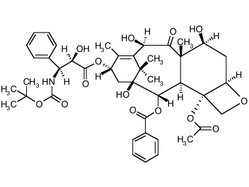Definition
Docetaxel is a drug used to treat certain types of cancer. Docetaxel is available under the trade name Taxotere.
Purpose
Docetaxel is an antineoplastic agent used to treat breast cancer and non-small cell lung carcinoma.
Description
Docetaxel was approved by the Food and Drug Administration (FDA) in 1996.
Docetaxel is a synthetic derivative of the naturally occurring compound paclitaxel. Docetaxel is synthesized from the naturally occurring compound, 10-deacetyl baccatin III, which is extracted from the needles of yew plants. Docetaxel belongs to a group of chemicals called taxoids. The chemical structure and biological action of docetaxel is similar to that of paclitaxel.
Docetaxel promotes the formation of microtubules that do not function properly. One of the roles of normal microtubules is to aid in the replication of cells. By disrupting this function, docetaxel inhibits cell replication.
Docetaxel is used in patients who have breast cancer that has recurred or progressed following treatment with other drugs. It is also used to treat non-small cell lung carcinoma alone, or in combination with platinum-containing drugs such as cisplatin. Statistically significant increases in survival times have been observed in patients treated with regiments that include docetaxel compared to control populations.
Recommended dosage
There is no known antidote for docetaxel overdose, so patients should be carefully monitored during treatment for toxicity.
Docetaxel is administered intravenously, in a dose that ranges from 60-100 mg/m2, over one hour, once every three weeks. The initial dose may be adjusted downward depending on patient tolerance to the toxic side effects of the drug. Also, blood tests may be necessary to ensure that the bone marrow is functioning adequately to continue treatment at the recommended interval.
All patients should be pretreated with corticosteroids such as dexamethasone prior to docetaxel administration, to help prevent adverse side effects. These side effects include severe hypersensitivity to docetaxel treatment and fluid retention. Premedication should start one day prior to docetaxel treatment and continue for three to five days.
Precautions
Docetaxel should only be used under the supervision of a physician experienced in the use of cancer chemotherapeutic agents. Special caution should be taken to monitor the toxic effects of docetaxel, especially suppression of bone marrow function and hypersensitivity reactions. Premedication to prevent hypersensitivity reactions is recommended. Minor to severe hypersensitivity reactions may occur within a few minutes of the start of treatment. Severe hypersensitivity requires treatment to stop. Docetaxel has a low therapeutic index at its maximum recommended dosage. Certain complications will only be possible to manage if the necessary diagnostic and treatment resources are readily available.
Because docetaxel is administered intravenously, the site of infusion should be monitored for signs of inflammation.
Adverse effects of docetaxel treatment in patients with significant liver dysfunction are more likely. High doses of treatment may also increase the likelihood and severity of adverse side effects.
Docetaxel should not be administered to patients who are known to have severe hypersensitivity to polysorbate 80, which is a component of the treatment that helps dissolve the drug.
The safety of docetaxel in children under 16 years of age has not been established.
Docetaxel can cause harm to a fetus when administered to pregnant women. Only in life-threatening situations, should this treatment be used during pregnancy. Women of child bearing age are advised not to become pregnant during treatment. Women should stop nursing before beginning treatment, due to the potential for serious adverse side effects in the nursing infants.
Side effects
Suppression of bone marrow function is the principal adverse side effect associated with docetaxel treatment. Blood tests will allow a doctor to determine if there is adequate bone marrow function to begin or continue treatment. Hypersensitivity and fluid retention may also occur during treatment. Corticosteroids are administered prior to treatment to help alleviate these side effects. Ulceration of the mouth and surrounding areas is possible. Additional side effects, including fever, decrease in blood pressure, nausea and vomiting, diarrhea, pain, abnormal liver function, skin rash, nerve damage, and hair loss (alopecia) may occur.
Interactions
As of 2001, no formal studies have explored the interactions between docetaxel and other medications. Drugs that may alter the metabolism of docetaxel such as cyclosporine, terfenadine, ketoconazole, erythomycin and troleandomycin should be used with caution due to the potential for interactions.
KEY TERMS
- 10-deacetyl baccatin III
- A naturally occuring compound that can be converted to docetaxel.
- Hypersensitivity
- An abnormally sensitive reaction to a stimulus. Similar to an allergic reaction.
- Microtubles
- A tubular structure located in cells that help them to replicate.
- Taxoids
- A complex molecule that is chemically similar to paclitaxel.
- Therapeutic index
- A ratio of the maximum tolerated dose of a drug divided by the dose used in treatment.



